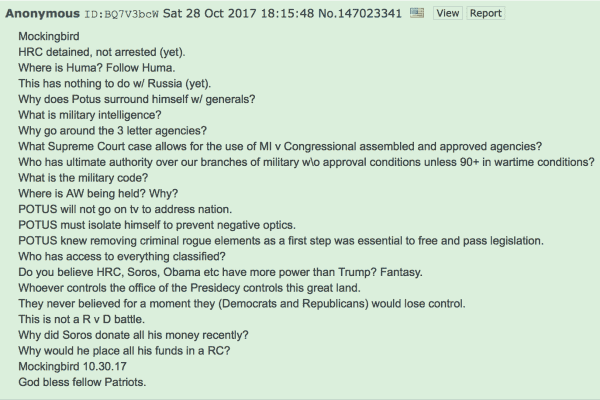
The Russia investigation is a sham. It’s actually a cover story for special counsel Robert Mueller and Donald Trump working together to expose thousands of pedophiles hidden in plain sight — including Hillary Clinton (and Bill Clinton, and Barack Obama), who will soon be under arrest. (Or perhaps already have been, and they’re on their way to Guantanamo Bay.)
The GOP lost the Alabama special election for Jeff Sessions’s Senate seat on purpose — a plan devised years ago to reveal the use of fraudulent voting machines and, ultimately, take down none other than George Soros. Or the Rothschilds. Or the Illuminati.
And there’s no White House chaos at all; in fact, despite legal scandals and special counsel investigations and bile-laden tweets, everything, absolutely everything, is going just as Donald Trump intended it.
Welcome to QAnon, sometimes referred to as “the Storm.” It’s a conspiracy theory that’s swept social media and is starting to break into the mainstream, with Trump rally goers in Florida on July 31 holding signs and wearing T-shirts emblazoned with “We are Q” and the conspiracy theory’s main catchphrase, “Where we go one, we go all.”
Roseanne, formerly the star of the No. 1 show on network television, is just one of Q’s biggest supporters. And the conspiracy theory is being pushed by some of the far-right’s biggest voices, including Alex Jones and Sean Hannity. Still others are winking and nodding at it, retweeting #QAnon references while pretending to be none the wiser.
And it has one overarching — and, if you’re a Trump supporter, hopeful — message: Donald Trump is in complete control. Of everything.
Conspiracy theories create order out of chaos, attempting to make sense of events that don’t make sense. And researchers have found that fact-based arguments against them only serve to reinforce them in the minds of believers. That’s what makes QAnon or Sandy Hook trutherism or any other conspiracy theory so difficult to combat: Because conspiracy theories aren’t based on facts, conspiracy theorists aren’t receptive to them, either.
So if the first year and a half of the Trump administration has been enmeshed in confusion and chaos, QAnon is the conspiratorial response: everything is fine. As a popular saying among Q adherents proclaims, believers must only “trust the plan.”
“God bless fellow patriots”
The beginnings of “the Storm” lie with Donald Trump himself.
On October 5, 2017, during a photo opportunity held before a military dinner, Trump said that the dinner was “Maybe the calm before the storm.” When a reporter asked, “What storm, Mr. President?” Trump responded, “You’ll find out.”
For non-conspiracy theorists, this was Trump-speak. He tends to just say things that have little to no relevance in anything either he, or his administration, will actually do — like that “maybe we should give” the Chinese style of one-man dictatorship “a shot.”
But for conspiracy theorists on Reddit, already primed to believe in code words and secrets and, well, conspiracies, “the Storm” soon became the most important “movement” of the Trump era.
The first post from an anonymous user alleging to be a high-level government informant came on October 28, on the 4chan message board /pol/. The user was nicknamed “Q” after Q-level security clearance, the Department of Energy equivalent of “Top Secret.” (“NG” is referring to the National Guard.)
A few hours later, Q posted again, adding coded phrases that /pol/ users would interpret and argue over for months. In short, he or she appeared to state that Hillary Clinton had been “detained” by authorities and that Trump knew that “criminal rogue elements,” including Clinton, had to be arrested, while referencing billionaire philanthropist George Soros, himself the subject of a number of conspiracy theories.

These postings were thrilling for people steeped in far-right conspiracy theory lore — from the very real Operation Mockingbird, a CIA effort to blackmail journalists and give out false information to share propaganda, to the wild theory that Huma Abedin, a former Hillary Clinton staffer and ex-wife of Anthony Weiner, was secretly working for the Muslim Brotherhood. (She wasn’t.)
Even the name Q seemed to imply that this person knew things others didn’t. The rapidly expanding group of people who follow Q’s postings — and believe them — became known as QAnon.
Q has tried to offer “proof” that he, she, or they have real intel. (They posted images that Redditors believed confirmed Q was on Air Force One, and thus had real information from the president himself.) Some followers even believe that Trump himself is Q — though others think it’s John F. Kennedy Jr., whom they believe faked his 1999 death.
Q offered real hope to Trump supporters: Everything is fine, Trump has everything under control, and everyone who stands in his way will soon be sent to prison. Literally.
In a posting from Q on November 1, 2017, Q said that on November 3 and 4, John Podesta, chair of Hillary Clinton’s 2016 campaign, would be arrested, military control would take hold, and “public riots would be organized in serious numbers to prevent the arrest and capture of more senior public officials.”
Obviously, none of this happened. There were no public riots or mass arrests or the use of emergency broadcasts. (In fact, the Emergency Broadcast System went out of service in 1997, replaced by the Emergency Alert System.)
The overwhelming majority of Q’s assertions are hilariously untrue: North Korean leader Kim Jong Un was placed in power by the CIA, Seth Rich was murdered by MS13 under orders from former DNC chair Debbie Wasserman Schultz, that many prominent Democrats are currently wearing ankle monitors because they are secretly under arrest.
The fact is that QAnon’s base assertion — that Trump really is in control of everything — is an inherently strange one to make when the Trump administration does, actually, control the entire federal government.
But that didn’t stop QAnon from percolating, first moving from 4Chan to 8chan (4chan’s weirder equivalent), and then pushing outward on the internet, to Twitter and YouTube, with believers making “explainer” videos about QAnon that get hundreds of thousands of views.
Conspiracy theorists and members of the alt-right and far-right were among the first to jump on the QAnon bandwagon. (Though some have decided Q has been “compromised.”)
But so did leaders of a right-leaning anti-abortion group, and so did some celebrities, like Roseanne Barr. As New York magazine’s Paris Martineau detailed in December 2017, the QAnon hashtag has been used so many times on Twitter it’s now virtually untrackable.
QAnon is now about everything — and it’s in the real world
QAnon has only gotten bigger over the past few months. Former MLB pitcher and conservative pundit Curt Schilling shared this video on Twitter in June, which alleges that QAnon isn’t just about Trump. It claims every US president before Trump was engaged in a criminal conspiracy with pedophile rings and the “deep state” and pharmaceutical companies, all to enslave the American people.
Q occasionally references the Pizzagate conspiracy theory, which led one man to walk into a pizzeria in Washington, DC, with an assault rifle because conspiracy theorists claimed that Hillary Clinton and her former campaign chair, John Podesta, ran a child sex ring in the basement. Accusations of pedophilia aimed at celebrities, companies, and politicians are a critical part of QAnon.
Roseanne and others have tweeted that the purportedly “unprecedented” increase in sex trafficking arrests taking place under the Trump administration is the direct result of Trump working with Mueller to arrest pedophiles nationwide (for the record, there has not been an “unprecedented” increase in sex trafficking arrests.)
There’s a reason for this: As Slate’s Christina Cauterucci wrote in July, accusations of pedophilia are the easiest and most effective way to tarnish someone’s reputation with no proof necessary, as pedophilia is universally considered a horrific and horrendous affront.
And since perhaps the only thing even more horrendous is the murder of children, it’s no wonder, then, that one of the main proponents of QAnon posted on YouTube that Americans would be forced to comprehend “films of innocent children pleading for their lives while people are butchering them” once “the Storm” came to pass. QAnon isn’t about protecting Trump, in their view. It’s about saving children from rape and murder — and who could oppose that?
But the open-source nature of QAnon, where Q posts something for thousands of other people to interpret as they see fit, means other conspiracy theories fit neatly within QAnon — like ones about false flag shootings, Jewish bankers controlling the world, or the Illuminati. As the Daily Beast’s Will Sommer wrote in July:
One recent example: When NBC’s Ben Collins went on the Today show on Wednesday to attempt to explain QAnon, one poster alleged that his script had been “written by Jacob Rothschild.” The Rothschild family has been the center of anti-Semitic conspiracy theories for centuries and, for the record, Jacob Rothschild is 82 years old, lives in England, and is not writing “scripts” for the Today show.
Beginning in early 2018, QAnon adherents made their way to the world outside the internet. In April, 200 QAnon supporters marched in DC. In June, when the Inspector General released its report criticizing the actions of FBI officials like former Director James Comey during the investigation into Hillary Clinton’s emails, QAnon insisted there was a second, secret report, which would send virtually every high-level Democrat to Guantanamo Bay, if they weren’t already on their way.
One man, Matthew Wright, took a rifle and a handgun and barricaded himself in his car on the Hoover Dam, holding a sign reading “RELEASE THE OIG MEMO,” referring to that second, hypothetical report.
And Michael Avenatti, Stormy Daniels’s attorney, was allegedly followed in person by a QAnon believer on July 29, while Q posted that a “message” had been sent.
As the Pizzagate incident in Washington, DC, showed, conspiracy theories breaking into the real world have consequences. And those consequences can be extremely dangerous in a charged political climate — and in a media environment with no overarching guardrails — where nothing is false and anything could be true.
Conspiracy theories are hard to fight because they’re about what we want to believe
Other conspiracy theorists have attempted to throw cold water on QAnon, like this blogger who wrote that he too had been a believer but, after reviewing the evidence, concluded that he had “been tricked” by a LARPer (live action role player) creating a fantastical story for their own entertainment. But true believers remain deeply committed.
Conspiracy theories like QAnon are “self-sealing” — meaning that evidence against them can become evidence of their validity in the minds of believers, according to Stephan Lewandowsky, a professor at the University of Bristol who studies conspiracy theories and conspiracy theorists. Trying to disprove a conspiracy theory, thus, usually only serves to reinforce it.
“For example, if scientists are accused of creating a “hoax,” such as climate change, but they are then exonerated by multiple enquiries, then a conspiracy theorist will not accept that as evidence of their innocence, but as evidence of a broad conspiracy (to create a world government or whatever) that involves the government, judiciary, Soros, and anyone else who once shared a supermarket checkout line with Al Gore in the 1970s,” Lewandowsky said.
And here’s the really important point: Conspiracy theories aren’t created by evidence, but by belief, or by the desire to believe, that there must be something more to the events that shape our lives, culture, and politics than accident or happenstance.
Where there is confusion, or even pain and tragedy, QAnon, or shootings termed “false flags,” or 9/11 trutherism brings some semblance of order and security. 9/11 was so horrific that it can’t possibly have happened without President George W. Bush being behind it somehow, orchestrating it behind the scenes. A mass shooting at an elementary school that killed dozens of small children is so terrible that it can’t possibly have really happened. And the Trump administration must only seem to be enmeshed in constant chaos.
As Lewandowsky told me:
Let’s be clear: Most people have never heard of QAnon, or Q — and that includes most of Donald Trump’s supporters. But there are those who do believe in QAnon — that Trump and Mueller are actually working together to arrest Democrats and Obama officials (who are all also pedophiles and cannibals), that everything is actually under control.
QAnon provides a soothing balm, telling believers that the only people who really know what’s going on are the believers — and the president.
Sourse: vox.com





